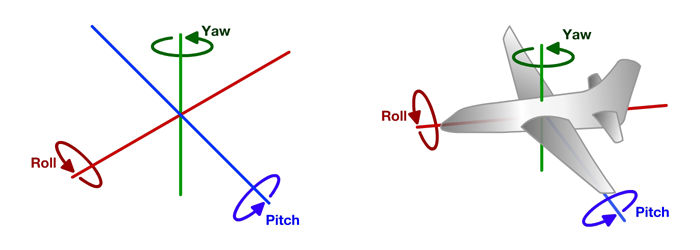Pitch, Roll, and Yaw
As an airplane moves through the air it also can rotate about its center of gravity in three axes. Rotation along the lateral axis (found by drawing a from one wing-tip to the other through the body of the plane) is called pitch and is controlled by the elevator. Rotation along the longitudinal axis (found by drawing a line from the front of the plane to the rear along the body) is controlled by the ailerons on the wing and is called roll. Rotation along the vertical axis (found by drawing a line from the ground straight up through the plane—perpendicular to the body) is called yaw and is controlled by the rudder. Most light airplanes are designed to be stable in pitch, yaw, and roll. The control surfaces are designed to maintain that stability.

“The pitch axis is perpendicular to the aircraft centerline and lies in the plane of the wings. A pitch motion is an up or down movement of the nose of the aircraft. ” NASA
The empennage is where the control surfaces for pitch and yaw are generally located. Most pilots refer to the empennage as the tail or tail assembly. It consists of two parts—the horizontal stabilizer and the vertical stabilizer. The vertical stabilizer is often referred to as the fin.
The vertical stabilizer provides stability along the yaw axis. The rudder pedals inside the cockpit control the rudder to move the nose of the plane to the left or right. Many airplanes also have rudder trim to relieve pressure on the pedals. Notice in the slide show that there aren’t many variations in rudder design. The V-tail shape of the Bonanza and the Fouga jet being the only major exception to a vertical stabilizer and rudder. This configuration is known as a ruddervator. Some airplanes, like the Cessna Skymaster, with an engine in the rear have two vertical stabilizers. The Lockheed P-38 Fighter is probably the most famous of the twin boom aircraft. Older fabric-covered planes like the Cessna 120 and aerobatic planes like the Pitts have rounded control surfaces. Otherwise the fins is pretty standard.
The horizontal stabilizer and elevator on the other hand have much more variation. Most light aircraft have a horizontal stabilizer that is in line with the fuselage. Some have the horizontal stabilizer at the top of the fin. These are called T-tails. Some aircraft look like they have two fins and are called V-tails. The horizontal stabilizer has the elevator, which controls pitch. Many light aircraft also have elevator trim, to relieve control pressures on the yoke.
Piaggo Avanti, Beech Starship and the Rutan designed Long-EZ have the elevator in the front of the airplane. This design is called a canard. The horizontal surface provides lift as well as controlling pitch. With these designs the rudders are on the wing tips and the engine is in the rear, pushing the airplane.
Almost all light airplanes use ailerons to rotate about the roll axis. Some airliners use a spoiler, located in the middle of the wing and the Wright brothers used wing-warping.
The Aircraft Aerodynamics and Design Group at Stanford has and interesting article on tail design and the relative advantages and disadvantages of various designs.
Summary
Roll—along the longitudinal axis—is controlled by the ailerons;
Pitch—along the lateral axis—is controlled by the elevators;
Yaw—along the vertical axis—is controlled by the rudder.


